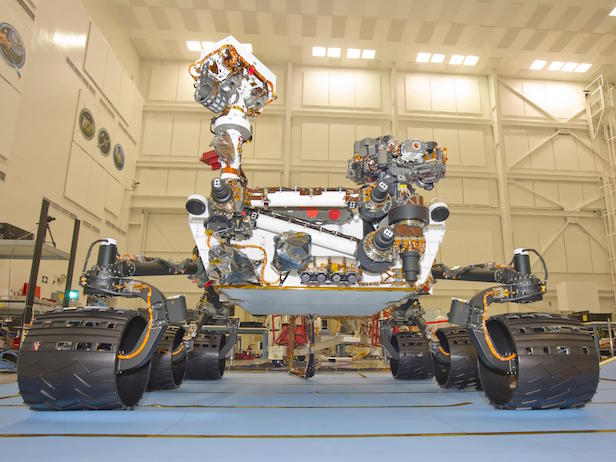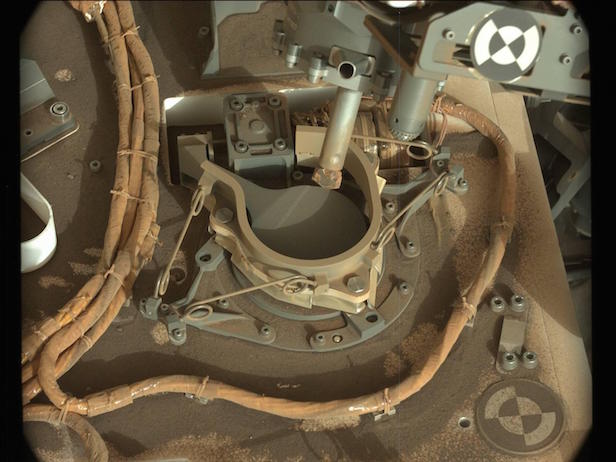Curiosity’s laboratories are back in action
The Martian rover is now able to drill and analyse rock samples of Mars again

Testing the drilling technique on Earth is difficult as the Martian surface conditions are very different. Image credit: NASA/JPL-Caltech
NASA’s Curiosity rover is back to its old tricks by analysing rock samples on Mars now that one of its onboard laboratories is functioning for the first time in over a year. The last time the rover drilled into the dry Martian soil in order to gather rock samples was back in October 2016.
“This was no small feat. It represents months and months of work by our team to pull this off,” says Jim Erickson, project manager of the Mars Science Laboratory (MSL) mission, which is led by NASA’s Jet Propulsion Laboratory (JPL) in Pasadena, California, United States. The Curiosity rover is part of the MSL mission. “JPL’s engineers had to improvise a new way for the rover to drill rocks on Mars after a mechanical problem took the drill offline in December 2016.”
On 20 May, Curiosity performed a unique technique called ‘feed-extended drilling’, which allowed the rover to drill into its first rock sample since October 2016. On 31 May, Curiosity underwent a more advanced technique called a ‘feed-extended sample transfer’ successfully, which transferred rock powder to the rover’s mineralogy laboratory for further analysis. The powder will then make its way into the chemistry laboratory in the week to follow.
The tests for both the new drilling method and the sample-delivery system is still a work in progress, as Curiosity’s engineers will develop and improve the technique based on the results from Mars. These recent results mark a major milestone for the mission, explained by Ashwin Vasavada of JPL, the mission’s project scientist.
“The science team was confident that the engineers would deliver – so confident that we drove back to a site that we missed drilling before. The gambit paid off, and we now have a key sample we might have never gotten,” says Vasavada. “It’s quite remarkable to have a moment like this five years into the mission. It means we can resume studying Mount Sharp, which Curiosity is climbing, with our full range of scientific tools.”

The drill bit on NASA’s Curiosity Mars rover is over one of the sample inlets on the rover’s deck. Image credit: NASA/JPL-Caltech/MSSS
The new sample-transfer technique allows Curiosity to position its drill over two small inlets on top of the rover’s deck, trickling in the appropriate amount of rock powder for the onboard laboratories to do their analyses.
This delivery method has proven successful on Earth, but the conditions are very different on the Red Planet. For one thing, the atmosphere is thin and dry and the gravity is a third of Earth’s. These factors play a part when it comes to powder falling out of the drill.
“On Mars we have to try and estimate visually whether this is working, just by looking at images of how much powder falls out,” says John Michael Morookian of JPL, the engineer who led development of the new sample-delivery method. “We’re talking about as little as half a baby aspirin worth of sample.”
If there is too little powder, the laboratories can’t undergo accurate analysis. On the other hand, if there is too much, it could overfill the instrument, clog parts and contaminate any future measurements. On 22 May, a successful test of the delivery method can now lead to more improvements to this technique.
Part of the challenge that now faces Curiosity engineers is that the rover’s drill is now permanently extended. The new configuration no longer gives access to a special device that sieves and portions drilled samples in precise amounts. That device, called the Collection and Handling for In-Situ Martian Rock Analysis (CHIMRA), played an important role in delivering measured portions of sample to the laboratories inside the rover.
Keep up to date with the latest reviews in All About Space – available every month for just £4.99. Alternatively you can subscribe here for a fraction of the price!




